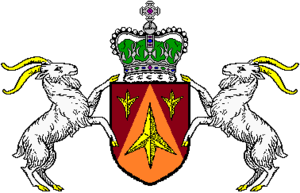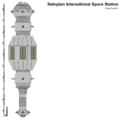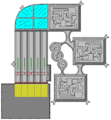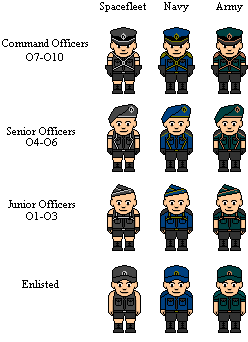Natopian Defense Force
The Natopian Defense Force is a combined arms force tasked, under the Caprine Code with defending the totality of Natopia's holdings on Micras and in the wider Atos system. It's motto is Duty, Loyalty, Honor. It is ultimately under the command of the Natopian Emperor, who has the supreme rank of Grand Commander of the Defense Force. Most operations and decisions are made by the Natopian Secretary for Defense.
(WiP)
Note to self. General structure is as follows:
Court of the Verdant Gardens (CVG)>> Natopian Defense Force (NDF) >> Service Branches >> Commands >> Fleets/Forces >> Divisions/Groups
Natopian Army
- Land Command
- Rapid Reaction Force
- Tapferite Army of Vengeance (raised circa 1649 to suppress an uprising in Walstadt)
- I “Asara” Division
- II “Shapur” Division
- III “Rostam” Division
- IV “Dominus” Division
- Demesne Defence Forces (Wartime only)
- Arboreal Demesne Defence Forces
- Most Serene Union's Armed Forces
- Klaasiyan Elite Forces
- Dynastic Guard of Flaventia
Organisation
- Board of the Admiralty (commanded by the Lords Commissioners of the Admiralty)
- Naval Command (commanded by an admiral)
- Gaeos Fleet (commanded by a vice-admiral)
- 1st Carrier Group (commanded by a rear-admiral)
- 1st Support Group
- 1st Home Group
- 2nd Home Group
- Raynor Fleet
- 2nd Carrier Group
- 3rd Home Group
- 1st Submarine Group
- Dominion Fleet
- 1st Exploratory Group
- 2nd Exploratory Group
- 3rd Exploratory Group
- 4th Exploratory Group
- Gaeos Fleet (commanded by a vice-admiral)
- Coastal Command
- Royal Fleet
- Royal Yacht Group
- Tapfer Fleet
- Bay Patrol Group
- Cibola Fleet
- Yardistan Fleet
- Royal Fleet
- Naval Command (commanded by an admiral)
| Type | # in Service | # Lost 1654/55 | # Lost 1656 |
|---|---|---|---|
| . | . | . | . |
3 Kesh class attack submarines (ex-Florian)
13 Indigo class gunboats (ex-Florian)
4 Bijeko class missile cruisers (ex-Florian)
1 Zibertian class cruiser (ex-Florian)
5 Northman class corvettes (ex-Florian)
3 Rey class submersible destroyers (ex-Florian)
Gallery
Natopian Spacefleet
The Spacefleet, in its present form, has been in continuous existence since 1571. Over the period of time the fleet has seen individual vessels progressively rebuilt through maintenance and life-extension programmes as well as entire classes withdrawn from service or redesigned.
The Natopian Spacefleet developed faster-than-light travel through unknown and clandestine means. The technology was once widespread throughout the fleet when regular missions to Giess and brief visits to Daia necessitated FTL speeds. Most ships are outfitted with a traditional spacewarp, known as Vastadenu Drive, which required a mineral component that is rare on Micras but abundant on Giess. Because of Giess' disappearance, the Spacefleet has enacted a strict sublight cruising policy to preserve the minerals for critical uses only. Newer classes have a vortex jump drive which has proven to be a more stable method of transport and does not require crystals or such.
The Natopian International Space Station was built in orbit and hosted international teams of scientists, diplomats, and provided logistical support for other nation's space programs. The most notable early exchange program was with the Karnali space program, where both national space agencies built a Bismarck class ship together and launched it as the KSS Karnali. According to Natopia's law, the Spacefleet maintains organizational autonomy outside of Micras' atmosphere, which allows the NISS and any Spacefleet assets stationed there to act as necessary in the harsh realities of space. Unless re-positioned for reconnaissance or classified missions, the NISS is found in a geosynchronous orbit over Angus Spaceport with several drydock facilities nearby (relatively).
A smaller version of the NISS, Natopian Station 2, was once in orbit around Giess.
New Lindstrom Tarsica Base was created when an old style Imperial-class carrier was dissembled in lunar orbit and reassembled on the surface of Tarsica. It has not always been manned, depending on the priorities of the NDF command staff, the civilian government, and whether or not other nations have personnel on the moon. The base is currently permanently manned, and the Guinevere Dome contains the transplanted remnants of the Hazel tribe, who fled their native Flaventia after a terrible fire.
The NSS Ganymede, an Io-class cruiser, was lost in a wormhole in 1593 during a standard patrol route between Giess and Micras. That same year the AlexNat Gate suddenly reopened and an invasion of the Grand Commonwealth poured into Klaasiya on Micras. It was later discovered that both the Ganymede wormhole and AlexNat Gate had opened into the parallel mirror universe of Meekras, where neither the Grand Commonwealth nor the SPEAR alliance collapsed and waged global war for years.
The War of Lost Brothers and the ongoing War of the Harpy compelled the Natopian Spacefleet to rebuild its aerospace arm for counterinsurgency operations in Normark.
As the primary spacefaring power of the Raspur Pact, the Natopian Spacefleet has exclusive operational control of the alliance's Space Command, subordinated for administrative purposes under the Tapfer Theatre Command.
Organisation
- Aerospace Command
- Spacefleet Headquarters and Spacefleet Academy
- Spacefleet
- Deep Space Patrol Group
- Atos Patrol Group
- Natopian International Space Station (NISS)
- Tarsica Support Group
- Orbital Defence Force
- 1st (Fighter) Group
- 2nd (Bombardment) Group
- 3rd (Support) Group
- 5th Tactical Air Force
- 4th Strike Group
- 5th Bombardment Group
- 6th Training Group (Imperial Air Training School)
- Air Development and Test Wing
- 7th Reconnaissance Group
Establishment
| Type | # in Service |
|---|---|
| Imperial-class space carrier | 1 |
| Ariadne-class escort ship | 6 |
| Bismark-class battleship | 2 |
| Io-class cruiser | 2 |
| Natopian International Space Station | 1 |
| Dingo-class shuttle | 58 |
| HB-3 bomber | 8 |
| LB-2 bomber | 20 |
| N-1 fighter | 147 |
| N-2 fighter | 1 |
| Stealth fighter "Black Angel" | 5 |
| Raven-class personal shuttle | 18 |
| New Lindstrom Tarsica Colony modular assembly | 1 |
| Virgo-class scout ship | 13 |
| Zion-class survey ship | 8 |
| Drydock facility | 1 |
| A-10 Kambera | 28 |
| R-1 Whirdlebird | 200 |
| T-2 Saeqeh | 810 |
| T-3 Akintos | 220 |
Gallery
New Lindstrom Tarsica Colony
Ranks and Uniforms
The uniforms for each branch of the Defense Force are designed by the Institute of Heraldry within the Court of the Verdant Gardens and manufactured via a contract with Dingo Enterprises. Spacefleet uniforms are consist of dark gray pants and tanktop (for arm mobility in potential zero-g situations) with silver-colored leather straps, and a side cap with silver piping. Navy uniforms are blue pants and longsleeve shirts to protect against the elements while on deck with gold-colored leather straps, and a standard cap with gold piping. Army uniforms are dark teal with rolled up sleeves, bronze-colored leather straps, and a beret with bronze piping.
Ranks
| Rank Grade | Space Fleet | Navy | Army |
| OF-10 | Fleet Marshal | Grand Admiral | Field Marshal |
| OF-9 | Marshal | Admiral | General |
| OF-8 | Vice Marshal | Vice Admiral | Lieutenant-General |
| OF-7 | Sky Marshal | Rear Admiral | Major-General |
| OF-6 | Commodore | Commodore | Brigadier |
| OF-5 | Group Captain | Captain | Colonel |
| OF-4 | Wing Commander | Commander | Lieutenant-Colonel |
| OF-3 | Squadron Leader | Lieutenant Commander | Major |
| OF-2 | Flight Lieutenant | Lieutenant | Captain |
| OF-1 | Flying Officer | Midshipman | Lieutenant |
| OF0 | Pilot Officer | Ensign | Cornet |
| WO | Warrant Officer | Chief Petty Officer | Warrant Officer |
| OR-7 | Flight Sergeant | Master Petty Officer | Sergeant-Major |
| OR-6 | Chief Technician | Petty Officer | Staff Sergeant |
| OR-5 | Sergeant | Master Seaman | Sergeant |
| OR-4 | Corporal | Leading Seaman | Corporal |
| OR-3 | Senior Airman | Able Seaman | Lance-Corporal |
| OR-2 | Leading Airman | Seaman | Chosen Man |
| OR-1 | Airman | Rating | Private |
Notable officers
- Admiral Isacco Giustinianni, NDF Garrison Commander for Elijah's Rest, Allied Commander for Keltia Command.
History
- Historic reliance upon sea-power and orbital platforms
- The Natopian Navy under Elwynnese control
- Grand Commonwealth (Giess) invasion
- Problems with Calbionese pirates
- Raid on Walstadt after the death of Elijah
- Logistical support to Constancia in the Euran War
- War of Jingdaoese Immolation
- War of Vengeance against the regicide Adam
- Neutrality in domestic politics (compared to Shireroth and Jingdao)
- War of Lost Brothers
- Battle of Carama Bay
- Naval war against Passio-Corum
- War of the Harpy
| |||||||||||||||||||||||||||||||||||||





















